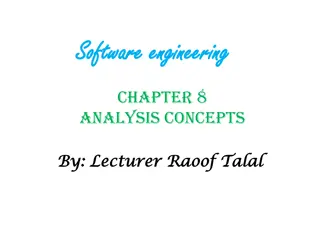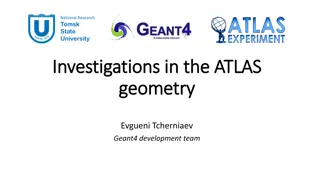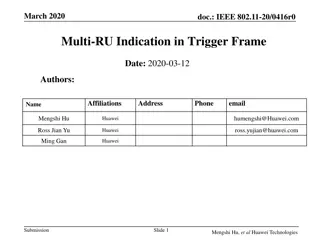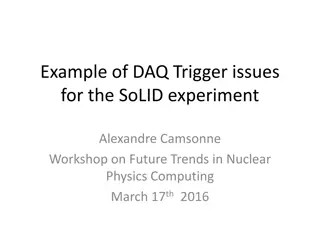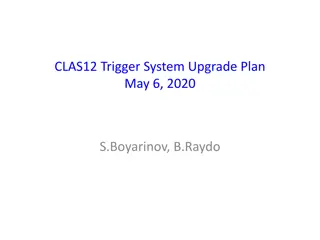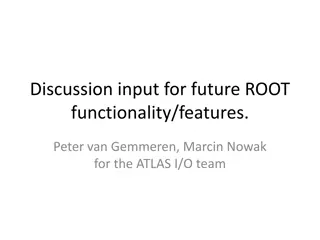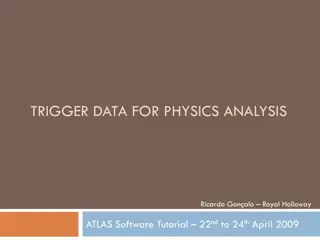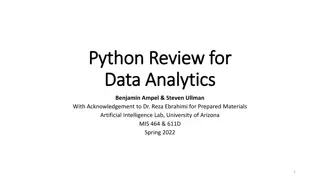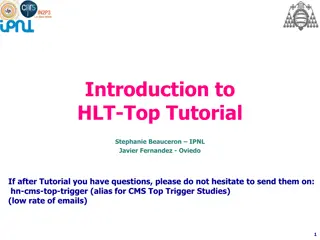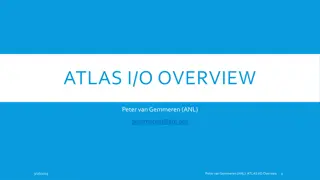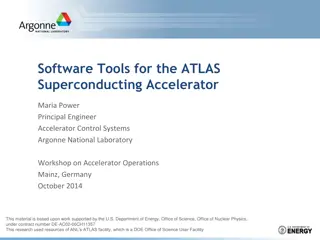Understanding ATLAS Software Tutorial on Trigger Data Analysis
This content delves into the significance and process of trigger data analysis in the context of ATLAS software tutorials. It covers topics such as Trigger Execution, Trigger Configuration, and Trigger-Aware Analysis, providing detailed insights into how triggers are configured, data is prepared, and analyses are conducted using trigger information. The tutorial explains the role of various algorithms, cuts, and multiplicities in trigger-based analysis, emphasizing the importance of monitoring prescales for accurate results.
Download Presentation

Please find below an Image/Link to download the presentation.
The content on the website is provided AS IS for your information and personal use only. It may not be sold, licensed, or shared on other websites without obtaining consent from the author. Download presentation by click this link. If you encounter any issues during the download, it is possible that the publisher has removed the file from their server.
E N D
Presentation Transcript
ATLAS Software tutorial 9th 12rdFebruary 2010 Trigger Data for Analysis J rg Stelzer DESY Ricardo Gon alo RHUL
The Trigger EM ROI L2 calorim. Level1: Region of Interest is found and position in EM calorimeter is passed to Level 2 Electromagnetic clusters cluster? L2 tracking track? Level 2 seeded by Level 1 Fast reconstruction algorithms Reconstruction within RoI match? E.F.calorim. E.F.tracking track? Ev.Filter seeded by Level 2 Offline reconstruction algorithms Refined alignment and calibration e/ reconst. e/ OK? ATLAS Software Tutorial - Trigger Data 2
The Trigger Execution The Trigger Execution FEX algo s are executed to create features on which selection in HYPO algo s is based FEX EM ROI EM ROI EM_ROI Feature L2 calorim. L2 calorim. HYPO TEPass/Fail TrigEMCluster cluster? cluster? Chain: Started, if seed has fired and chain is not PRESCALED Stopped AT STEP, if a HYPO is not passed Last HYPO passed CHAIN PASSED L2 tracking TrigInDetTracks track? match? Event: Passed, if at least one EF chain is passed Put into all streams that are associated with the passed EF chains E.F.calorim. E.F.calorim. TEPass/Fail CaloCluster E.F.tracking TEPass/Fail EFTrack track? Trigger objects associated with triggers through Navigation TriggerElements e/ reconst. e/ reconst. TEPass/Fail egamma Trigger information in TRIGGER DECISION + Configuration + + Navigation ESD AOD DPD TAG OK? OK? e OK? e OK? Feature ATLAS Software Tutorial - Trigger Data 3
Trigger Configuration + Data TriggerDB All configuration data Preparation Data taking Online Conditions Database COOL Encoded trigger result from all 3 levels Decoded trigger menu Reconstruction Trigger Result passed?, passed through?, prescaled?, last successful step in trigger execution? ESD amount of detail With decreasing Trigger EDM Trigger objects for trigger selection studies AOD Trigger aware analysis Trigger Configuration DPD Trigger names, prescales, pass throughs TAG access through TrigDecisionTool ATLAS Software Tutorial - Trigger Data 4
Trigger-Aware Analysis Introductory Comments Analysis based on single trigger chain or an OR of a few chains (a ChainGroup ) Chain definition algorithms, cuts, multiplicities do not change during a run, but can change between runs Important for analysis on DPD, where multiple runs are merged, check the ChainGroup content between each run Prescales at LVL1 and at HLT can change between luminosity blocks A negative prescale means that this trigger is off. This is important for calculating the integrated luminosity. Check each luminosity block. ATLAS Software Tutorial - Trigger Data 5
Bringing it Together TrigDecisionTool ESD AOD DPD contain persistent Configuration can change between runs Decision + Navigation EDM Configuration BUT: IOV based P/T conv. EDM P/T convertion Unpacking Dec. + Nav. Prescales can change between lumiblocks (trigger on/off) IOVDbSvc Upon Request ConfigSvc TrigDecision Feature Nav. Configuration Transient: TrigDecisionTool ATLAS Software Tutorial - Trigger Data 6
Whats there? Trigger Decision Lvl1 decision after dead-time veto HLT decision, information for pass-through ed and for resurrected triggers Bunch groups that fired For more detailed studies: Lvl1 decision before prescale, before veto Error codes for HLT-algorithms Last step of chain execution ATLAS Software Tutorial - Trigger Data 7
Tool Usage private: ToolHandle<Trig::TrigDecisionTool> tdt; 1.Alg.h: define ToolHandle to a TrigDecisionTool MyAlgo::MyAlgo(const std::string &name, ) tdt("Trig::TrigDecisionTool/TrigDecisionTool ) { } 2.Alg.cxx Alg::Alg(): declare ToolHandle as public tool 3.Alg.cxx Alg::initialize(): retrieve tool Has to be in initialize()! StatusCode sc = tdt.retrieve(); if (tdt->isPassed ( L2_e15i )) { log << MSG::INFO << I m happy! << endreq; } 4.Alg.cxx Alg::execute(): use tool TWIKI: Doxygen: https://twiki.cern.ch/twiki/bin/view/Atlas/TrigDecisionTool15 http://atlas-computing.web.cern.ch/.../TrigDecisionTool/html/ ATLAS Software Tutorial - Trigger Data 8
Working with ChainGroups const Trig::ChainGroup* mMyTrigger; 1.Alg.h: define ChainGroup pointer 2.Alg.cxx Alg::initialize(): declare ChainGroup Note: the ChainGroup automatically updates with each run (chain content) and lumiblock (prescales) Use regular expressions, e.g. EF_e.* mMyTrigger = tdt.createChainGroup( EF_e10_loose , EF_mu10 ,...); 3.Alg.cxx Alg::execute(): Access to trigger configuration bool useLB = ! mMyTrigger->getListOfTriggers().empty(); bool myEvent = mMyTrigger.isPassed(); Access to trigger decision const Trig::FeatureContainer fc = mMyTrigger.features(); const std::vector< Trig::Feature< TrigTau > > taus = fc.get(); Access to trigger objects Anonymous ChainGroups: Note that one can work without steps 1 and 2. In Alg::execute() define the triggers on the fly: Equally fast (TDT keeps ChainGroups) string tr ( EF_e10_loose ); bool useLB = ! tdt->getListOfTriggers().empty(tr); bool myEvent = tdt->isPassed(tr); const Trig::FeatureContainer fc = tdt.features(tr); ATLAS Software Tutorial - Trigger Data 9
Whats there? Features and Navigation Access to features through the TriggerNavigation Features are created by FEX algorithms, they appear in StoreGate. A FEX also creates a TriggerElement (TE) A TE is used as handle to the feature A TE has a pass/fail state set by the corresponding HYPO The navigation gives you all the features that were created in a chain Or just those that were successful (features in ROI s which passed all cuts) that is the default! Can also give you combinations of features (for multi-object triggers) Ancestor function to navigate, e.g. from electron to track and cluster ATLAS Software Tutorial - Trigger Data 10
Athena Example for using Features FeatureContainer f = tdt->features("EF_tau16i_loose_2j23"); // creating the feature container FeatureContainer for EF_tau16i_loose_2j23 std::vector< Feature<JetCollection> > jetColls = f.get<JetCollection>(); mLog << MSG::INFO << "Number of JetCollections: " << jetColls.size() << endreq; Access the feature You need to know the type of the Feature: JetCollection in EF if(jetColls.size()>0) { const Feature<JetCollection>& jcf = jetColls[0]; // get the first Feature mLog << MSG::INFO << "Label: " << jcf.label() << endreq; const JetCollection* jc = jcf; // implicit Feature -> object conversion Access the object (implicit conversion) mLog << MSG::INFO << "Number of Jets: " << jc->size() << endreq; JetCollection::const_iterator jIt = jc->begin(); for (; jIt != jc->end(); ++jIt ) { Access information of object Jet* jet = *jIt; mLog << MSG::INFO << "Jet e : " << jet->e() << endreq; Find corresponding L2 jet using TDT::ancestor<T> } // find the corresponding jets in Lvl2 through the inheritance tree (navigation does that all) Feature<TrigT2Jet> l2jetF = tdt->ancestor<TrigT2Jet>(jcf); mLog << MSG::INFO<<"Found << (l2jetF.empty()?"no ":" )<< "corresponding L2 Jet. <<endreq; if ( !l2jetF.empty() ) { Output: const TrigT2Jet* t2jet = l2jetF.cptr(); // explicit Feature -> object conversion Number of JetCollections: 1 TE Label: TrigJetRec Number of Jets: 1 Jet e : 82827.9 Found corresponding L2 Jet. e : 83197.4 mLog << MSG::INFO << " e : " << t2jet->e() << endreq; } } ATLAS Software Tutorial - Trigger Data 11
Trigger Object Matching Why? Some analyses require object level trigger information: Tag and Probe Some analyses have multiple objects of same type and need matching for detailed efficiency estimation Trigger selection design and optimisation Matching framework available in Trigger/TrigAnalysis/TrigObjectMatching package in release 15.3.0 and later Examples available in Trigger/TrigAnalysis/TrigAnalysisExamples in release 15.4.0 and later TrigMatchExAlg - Athena example of matching for each common offline type TrigMatchExampleARA - Example of trigger matching in ARA TagAndProbeExAlg - Athena example of tag and probe analysis with trigger matching TWiki available with detailed information for users and developers https://twiki.cern.ch/twiki/bin/view/Atlas/TriggerObjectsMatching ATLAS Software Tutorial - Trigger Data 12 09/02/201
Whats there? Configuration Data L1 Items: name, prescale For more detailed studies: version, CTP-Id, bunch group, thresholds and multiplicities HLT Chains: name, level, prescale, streams For more detailed studies: version, counter, trigger elements and multiplicities Trigger Release, configuration keys (useful for lookup in the TriggerDB) No access with the TDT, but checkConfigTrigger.py ATLAS Software Tutorial - Trigger Data 13
Configuration Access with the TDT std::vector< std::string > getListOfTriggers (const Trig::ChainGroup *chaingroup) const List of trigger names of the ChainGroup chaingroup getListOfStreams (const Trig::ChainGroup *chaingroup) const List of stream names of the ChainGroup chaingroup getListOfTriggerElements (const Trig::ChainGroup *chaingroup) const List of lists of TE names in ChainGroup chaingroup. Inner vectors are for a single trigger step, the length of those is the trigger multiplicity. getPrescale (const Trig::ChainGroup *chaingroup, unsigned int condition=TrigDefs::Physics) const Prescale of the ChainGroup chaingroup. std::vector< std::string > std::vector< std::vector< std::string > > float All methods come with two flavors, argument: const Trig::ChainGroup *chaingroup const std::string &triggerNames= .* Here the ChainGroup is created on the fly from the pattern triggerNames (regexp - .* means all ) All functions are forwarded from ChainGroup, tdt->fnc(chgr, ) is equivalent to chGr->fnc( ) Prescales: For single triggers the prescale combined for all levels is returned. If a multi- trigger ChainGroup contains an unprescaled trigger, the return value is 1. It is 0 otherwise. ATLAS Software Tutorial - Trigger Data 14
Tools to Investige the Trigger Setup http://trigconf.cern.ch: Main web portal to trigger configuration by run number, MC menu name, configuration keys Uses TriggerTool and AtlCoolTrigger.py underneath TriggerTool: Java based GUI to browse the TriggerDB (replica) for all information Also used at point 1 for preparation of trigger AtlCoolTrigger.py: Command line tool to show release, configuration keys, menu information, streams for data http://atlas-runquery.cern.ch/ Query page for trigger chains, prescales, trigger release for data ATLAS Software Tutorial - Trigger Data 15
Example for the Configuration Portal Go to http://atlas-trigconf.cern.ch 3. Browse the trigger configuration (definition, algorithms, selection cuts) 1. Enter run-range 2. Click on link in resulting run list Also with simple comparison functionality ATLAS Software Tutorial - Trigger Data 16
Trigger Menu Listing Trigger Menu and L1 rates stored in COOL, HLT rates coming. Quick access via AtlCoolTrigger.py (command line tool) AtlCoolTrigger.py r 91000 99000 (many run summary) AtlCoolTrigger v m r 90272 (single run menu) Prints keys, trigger menus, streams, allows diff ing of menus in different runs, creates menu in xml format Run summary pages (WEB based):http://atlas-service-db- runlist.web.cern.ch/atlas-service-db-runlist/query.html Trigger names, rates for single run ATLAS Software Tutorial - Trigger Data 17
TriggerTool Java based front end to TriggerDB, launch from the web (Java web-start): http://www.cern.ch/triggertool Overview of all trigger configurations (data taking and MC) Detailed and convenient investigation of trigger menus Trigger definition L1->L2->EF: prescales, threshold algorithms, selection criteria, streaming information, etc. Possibility to compare different trigger configurations Used at point 1 for trigger operation TDAQ training tutorial for the TT ATLAS Software Tutorial - Trigger Data 18
Scripts to Check Pool File Content File:AOD.pool.root Size: 55955.492 kb Nbr Events: 250 checkTrigger.py AOD.pool.root Runs over ESD/AOD/DPD and presents detailed (chain wise) counts of the trigger decision Trigger configuration summary: SMK: 0, HLTpsk: 0, L1psk: 0 Config source: TriggerMenuXML/LVL1config_MC_lumi1E31_no_prescale_15.1.0.xml and TriggerMenuXML/HLTconfig_MC_lumi1E31_no_prescale_15.1.0.xml L1 Items : 146 HLT Chains : 556 ================================================================================ ID level Trigger name Passed events: raw, after PS, after PT/Veto ================================================================================ LVL1 Global LVL1 250 LVL2 Global LVL2 250 EF Global EF (LVL3) 250 -------------------------------------------------------------------------------- 13 LVL1 L1_2EM13 71 71 71 14 LVL1 L1_2EM13I 34 34 34 163 LVL1 L1_2EM13_MU6 8 8 8 .... -------------------------------------------------------------------------------- ... 77 LVL2 L2_2g10 118 118 118 246 LVL2 L2_2g10_mu6 12 12 12 .... -------------------------------------------------------------------------------- ... 477 EF EF_2e6_medium 8 8 8 478 EF EF_2e6_medium1 7 7 7 79 EF EF_2g20 39 39 39 248 EF EF_2j42_xe30 3 3 3 .... ================================================================================ checkTriggerConfig.py d AOD.pool.root Runs on ESD/AOD/DPD and presents detailed trigger configuration(s) Shows multiple configurations (merged DPD) > checkTriggerConfig.py d data09_cos.00121733.physics_L1Calo.recon.ESD.r733_tid073522/ESD.073522._000001.pool.root.1 EF: EF_mu0_tgc_halo_IDSCAN (1.00), L2: L2_mu0_tgc_halo_IDSCAN (1.00), L1: L1_MU0_TGC_HALO (1) [streams: TGCwBeam] ATLAS Software Tutorial - Trigger Data 19
Trigger Content of Atlas-Runquery Hands-on session earlier Search for runs by release, configuration key, trigger content Display and have links to run-summary, AMI, trigconf.ch, e-log ATLAS Software Tutorial - Trigger Data 20
Summary Trigger data access in Athena, ARA, C++, or python with the TrigDecisionTool! Many examples, plus a large number of people to provide help when needed (hn-atlas-TriggerHelp at cern.ch) Tools to check the trigger information for given run Configuration: TriggerTool or http://atlas-trigconf.cern.ch Pool files: checkTrigger.py and checkTriggerConfig.py Prescales to be checked for each lumiblock luminosity Remember that negative prescale means trigger did not run Important for analysis: matching of offline reconstruction and trigger objects ATLAS Software Tutorial - Trigger Data 21
Additional Information Trigger user info: Tutorials: https://twiki.cern.ch/twiki/bin/view/Atlas/TriggerUserPages https://twiki.cern.ch/twiki/bin/view/Atlas/TriggerSoftwareTutorialPage TDT Twiki: TDT Doxygen: https://twiki.cern.ch/twiki/bin/view/Atlas/TrigDecisionTool http://atlas-computing.web.cern.ch/atlas- computing/links/nightlyDevDirectory/AtlasOffline/latest_doxygen/InstallArea/doc//T rigDecisionTool/html/index.html https://twiki.cern.ch/twiki/bin/view/Atlas/TriggerObjectsMatching Trigger obj matching: TrigAnalysisExample: http://atlas-computing.web.cern.ch/atlas- computing/links/nightlyDevDirectory/AtlasOffline/latest_doxygen/InstallArea/doc/Tr igAnalysisExamples/html/index.html UserAnalysis example: https://twiki.cern.ch/twiki/bin/view/AtlasProtected/UserAnalysis Trigger Configuration: http://trigconf.cern.ch TriggerTool: Run query: Trigger EDM: http://www.cern.ch/triggertool http://atlas-runquery.cern.ch/ https://twiki.cern.ch/twiki/bin/view/Atlas/TriggerEDM, http://alxr.usatlas.bnl.gov/lxr/source/atlas/Trigger/TrigEvent/TrigEventARA/TrigEvent ARA/selection.xml TriggerMenu group: TriggerSW group: TriggerConfig group: https://twiki.cern.ch/twiki/bin/view/Atlas/TriggerPhysicsMenu https://twiki.cern.ch/twiki/bin/view/Atlas/TAPMCoreSW https://twiki.cern.ch/twiki/bin/view/Atlas/TriggerConfiguration Help on e-groups: hn-atlas-TriggerHelp at cern.ch ATLAS Software Tutorial - Trigger Data 22
On the issues described above ATLAS Software Tutorial - Trigger Data 23
Whats there? Trigger Decision Lvl1 decision after dead-time veto HLT decision, information for pass-through ed and for resurrected triggers Bunch groups that fired For more detailed studies: Lvl1 decision before prescale, before veto Error codes for HLT-algorithms Last step of chain execution ATLAS Software Tutorial - Trigger Data 24
Decision Access with the TDT isPassed (const Trig::ChainGroup *chaingroup, unsigned int condition=TrigDefs::Physics) const bool true if given group of chains passed getBGCode () const char Get the bunch group code byte. BG X fired (X=0..7): getBGCode() & (0x1<<X) All trigger decisions through isPassed() , behavior depends on condition argument: TrigDefs::Physics: [default] Pseudonym for requireDecision | enforceLogicalFlow, which means that both conditions are applied. Default for isPassed() and for getPrescale(). TrigDefs::enforceLogicalFlow, TrigDefs::fullChain: combination of all three trigger levels. TrigDefs::requireDecision: A decision must have been made, pass due to pass-through or resurrection is not enough. TrigDefs::passedThrough: Event was passed through. A trigger chain can have a pass-through factor in order to record events independent of the decision. This is useful for understanding the trigger behavior. Restrict the isPassed() to those events, requireDecision must be off. TrigDefs::allowResurrectedDecision: If a trigger is prescaled on a given event, that trigger chain is not executed. If that event is accepted it is often important to know also the trigger decision and features of the prescaled trigger (orthogonal triggers for efficiency determination.) For a fraction of these cases we execute the trigger and safe its decision. This is accessed with allowResurrectedDecision (requireDecision must be off.) ATLAS Software Tutorial - Trigger Data 25
Whats there? Configuration Data L1 Items: name, prescale For more detailed studies: version, CTP-Id, bunch group, thresholds and multiplicities HLT Chains: name, level, prescale, streams For more detailed studies: version, counter, trigger elements and multiplicities Trigger Release, configuration keys (useful for lookup in the TriggerDB) No access with the TDT, but checkConfigTrigger.py ATLAS Software Tutorial - Trigger Data 26
Configuration Access with the TDT std::vector< std::string > getListOfTriggers (const Trig::ChainGroup *chaingroup) const List of trigger names of the ChainGroup chaingroup getListOfStreams (const Trig::ChainGroup *chaingroup) const List of stream names of the ChainGroup chaingroup getListOfTriggerElements (const Trig::ChainGroup *chaingroup) const List of lists of TE names in ChainGroup chaingroup. Inner vectors are for a single trigger step, the length of those is the trigger multiplicity. getPrescale (const Trig::ChainGroup *chaingroup, unsigned int condition=TrigDefs::Physics) const Prescale of the ChainGroup chaingroup. std::vector< std::string > std::vector< std::vector< std::string > > float All methods come with two flavors, argument: const Trig::ChainGroup *chaingroup const std::string &triggerNames= .* Here the ChainGroup is created on the fly from the pattern triggerNames (regexp - .* means all ) All functions are forwarded from ChainGroup, tdt->fnc(chgr, ) is equivalent to chGr->fnc( ) Prescales: For single triggers the prescale combined for all levels is returned. If a multi- trigger ChainGroup contains an unprescaled trigger, the return value is 1. It is 0 otherwise. ATLAS Software Tutorial - Trigger Data 27
Whats there? Features and Navigation Access to features through the TriggerNavigation Features are created by FEX algorithms, they appear in StoreGate. A FEX also creates a TriggerElement (TE) A TE is used as handle to the feature A TE has a pass/fail state set by the corresponding HYPO The navigation gives you all the features that were created in a chain Or just those that were successful (features in ROI s which passed all cuts) that is the default! Can also give you combinations of features (for multi-object triggers) Ancestor function to navigate, e.g. from electron to track and cluster ATLAS Software Tutorial - Trigger Data 28
Feature Access with the TDT features (const ChainGroup *group, unsigned int condition=TrigDefs::Physics) const const FeatureContainer returns all features related to given chain group template<class T> const Feature< T > ancestor (const HLT::TriggerElement *te, std::string label="") const gives back feature matching (by seeding relation) te - is trigger element to start with, note that thanks to conversion operators Feature object can be given here as well condition == TrigDefs::Physics: contains features where ROI passed the last HYPO condition != TrigDefs::Physics: all features created in trigger FeatureContainer: get (const std::string &label="", unsigned int condition=TrigDefs::Physics, const std::string &teName="") const template<class T> const std::vector < Trig::Feature< T > > returns flattened vector of Features of given type This method is in fact sullied by 3 arguments. const std::vector < Trig::Combination > & getCombinations () const returns reference to combinations collected through append Combination template<class T> const std::vector < Trig::Feature< T > > get (const std::string &label="", unsigned int condition=TrigDefs::Physics, const std::string &teName="") const Method used to get objects. ATLAS Software Tutorial - Trigger Data 29
Working with Features Access always a two or three step process 1. FeatureContainer fc from the TDT 2. List of Features<T> from fc or 2. List of Combinations from fc and 3. list of Features<T> from each Combination Feature< T > has access to Its constant object: const T* The TriggerElement to which the object has been attached This can be used with TDT::ancestor(TriggerElement*) method to find predecessors Label (key in SG) Feature< T >: operator const T * () const implicit conversion to object pointer (explicit conversion cptr () for python) operator const HLT::TriggerElement * () const implicit conversion to TriggerElement (explicit conversion te () for python) operator const std::string () const explicit conversion to feature label (explicit conversion label () for pyton) ATLAS Software Tutorial - Trigger Data 30
Expert Access with the TDT Some methods are not needed for most physics analyses, but for detailed trigger investigation (rate tool, timing tools, trigger validation) Access via Trig::ExpertMethods* em = tdt->ExperimentalAndExpertMethods(); em->enable(); ExpertMethods: const TrigConf::TriggerItem * getItemConfigurationDetails (const std::string &chain) Access to trigger configuration return TrigConf::TriggerItem chain: name of the item const TrigConf::HLTChain * getChainConfigurationDetails (const std::string &chain) return TrigConf::HLTChain chain: name of the chain const LVL1CTP::Lvl1Item * getItemDetails (const std::string &chain) const Access to complete trigger decision return LVL1CTP::Lvl1Item chain: name of the item const HLT::Chain * getChainDetails (const std::string &chain) const return HLT::Chain chain: name of the chain Access to Navigation getNavigation () const const HLT::NavigationCore * return HLT::NavigationCore ATLAS Software Tutorial - Trigger Data 31
Trigger Object Types FEXs create trigger objects, which they attach to a TriggerElement, sometimes with a Label. Two examples for the current 1031 menu and 15.4.0: InDet::Pixel_TrgClusterization/PixelClustering_Tau_EFID attaches PixelClusterContainer objects to EFtau16i_loosetr. TrigJetRec/TrigJetRec_Cone attaches JetCollection objects to EF_j23, this time with the extra label "TrigJetRec" Q: Which FEX creates what type of object and what label ? A: One needs to know the trigger software, and read the literature or look at the code. Use LXR and the algorithm classname to find out what is produced. This can be of help: Looking at the Trigger EDM TWIKI (type, label, slice, LXR): https://twiki.cern.ch/twiki/bin/view/Atlas/TriggerEDM Checking the AOD content (which labels exist for which type in the file): checkFile.py AOD.pool.root I recommend looking at TrigEventARA/selection.xml for the type used in the navigation (the one you need) ATLAS Software Tutorial - Trigger Data 32
Trigger Object Labels Feature access methods in the TrigDecisionTool have an optional argument label . These correspond to the StoreGate keys (minus "HLT_"). > checkFile.py checkFile.py AOD.pool.root AOD.pool.root | |grep grep TrigRoiDescriptor TrigRoiDescriptor 52.334 kb 5.552 kb 0.022 kb 0.199 250 (B) TrigRoiDescriptorCollection_tlp1_HLT_TrigCaloRinger 56.061 kb 7.773 kb 0.031 kb 0.186 250 (B) TrigRoiDescriptorCollection_tlp1_HLT_secondaryRoI_EF 63.160 kb 10.673 kb 0.043 kb 0.164 250 (B) TrigRoiDescriptorCollection_tlp1_HLT_forMS 63.160 kb 10.679 kb 0.043 kb 0.164 250 (B) TrigRoiDescriptorCollection_tlp1_HLT_forID 66.552 kb 11.474 kb 0.046 kb 0.156 250 (B) TrigRoiDescriptorCollection_tlp1_HLT_secondaryRoI_L2 96.685 kb 25.609 kb 0.102 kb 0.108 250 (B) TrigRoiDescriptorCollection_tlp1_HLT_TrigT2CaloEgamma 96.325 kb 27.150 kb 0.109 kb 0.108 250 (B) TrigRoiDescriptorCollection_tlp1_HLT_TrigT2CaloTau 110.456 kb 31.728 kb 0.127 kb 0.095 250 (B) TrigRoiDescriptorCollection_tlp1_HLT_TrigT2CaloJet 163.605 kb 38.949 kb 0.156 kb 0.065 250 (B) TrigRoiDescriptorCollection_tlp1_HLT_initialRoI 217.361 kb 60.725 kb 0.243 kb 0.050 250 (B) TrigRoiDescriptorCollection_tlp1_HLT 240.863 kb 70.211 kb 0.281 kb 0.046 250 (B) TrigRoiDescriptorCollection_tlp1_HLT_T2TauFinal Correct way to get the initial RoIDescriptor (build from LVL1 ROI): vector< Feature<TrigRoiDescriptor TrigRoiDescriptor> > roi = fc.get<TrigRoiDescriptor TrigRoiDescriptor>(" "initialRoI initialRoI" "); Note: the persistent data the type is TrigRoiDescriptorCollection, while through the navigation you get TrigRoiDescriptor objects. Again, the best way to find out is, at the moment, to look at TrigEventARA/selection.xml. ATLAS Software Tutorial - Trigger Data 33
Athena / ARA | C++ / python 14.2.22+: ARA with trigger data works, but limited to configuration and trigger object access. TrigDecisionTool and Navigation don t work with ARA here. 15.3.0+: new TrigDecisionTool. Everything works with ARA and like in Athena. Running over multiple files with different configurations works seamlessly Athena and ARA work both in C++ and in python Note templated functions syntax: C++: fc.get<TrigRoiDescriptor>("initialRoI") Python: fc.get('TrigRoiDescriptor')('initialRoI') Implicit convertions don t work in python Use Feature::cptr() and Feature::te() Examples for all 4 cases are in Trigger/TrigAnalysis/TrigAnalysisExamples ATLAS Software Tutorial - Trigger Data 34
Matching Framework Overview Two basic questions What chains is the offline object associated with? chainPassedByObject - does reco object match a passed trigger object in a given chain? chainsPassedByObject - list of chains that reco object passes What are the properties of the trigger object the offline object is associated with? matchToTriggerObjects - vector of trigger objects matching to reco object in given chain matchToTriggerObject - return best matching trigger object in given chain ATLAS Software Tutorial - Trigger Data 35 09/02/201
Matching Framework Implementation Three basic problems: Object distance x Obj A Obj B Float Generic object matching / Obj Bi1 x Obj A Obj B1 Obj Bn , , Obj Bi1 Obj Bim , , Trigger specific matching / x Obj A Chain Bool Obj Bi1 ATLAS Software Tutorial - Trigger Data 36 09/02/201
Some subtleties Distance definition is implemented as a function object and passed as an argument By default, R is used Arbitrarily complex matching possible Quality of matches Smallest R is not a guarantee of a good match Container type objects EF trigger objects attached as containers, so matches are to a container rather than an individual trigger object What it means to pass a chain Chain passed if match to trigger object associated with active trigger element For multi-object triggers or intermediate trigger objects, an offline object can pass a failed chain Relative trigger level efficiencies Possible to pass EF without passing L2 (passthrough, direction resolution effects) ATLAS Software Tutorial - Trigger Data 37 09/02/201
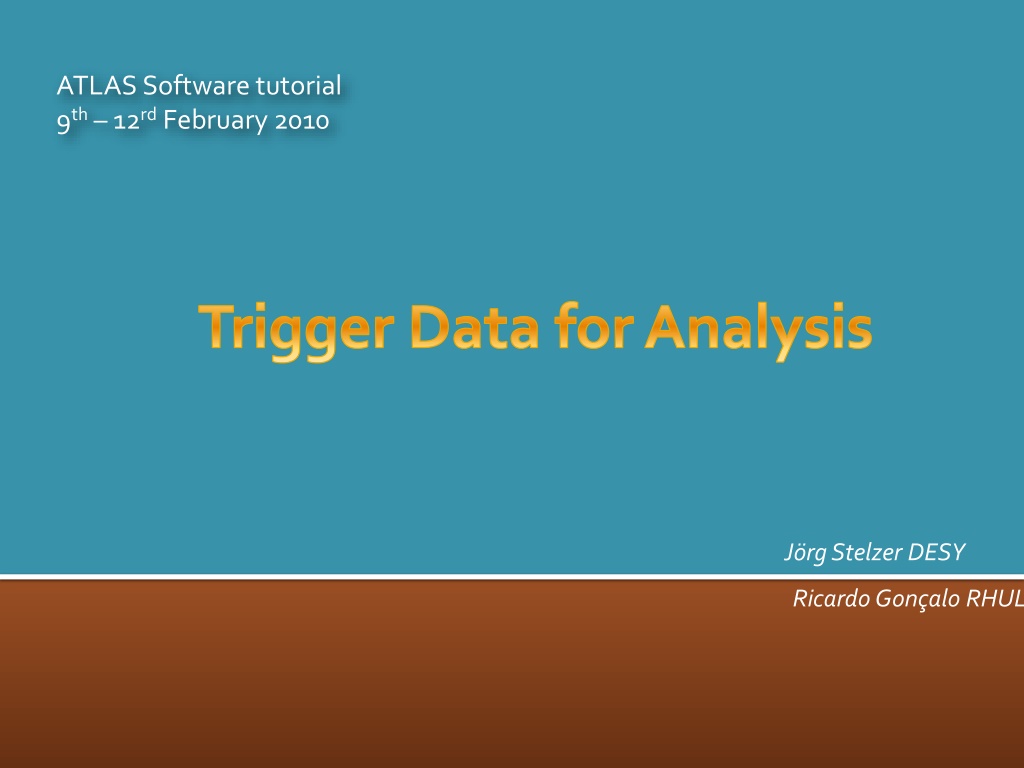

![[PDF⚡READ❤ONLINE] Road Atlas for the Total Solar Eclipse of 2024 - Color Editio](/thumb/21696/pdf-read-online-road-atlas-for-the-total-solar-eclipse-of-2024-color-editio.jpg)



